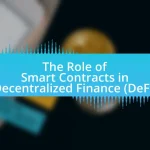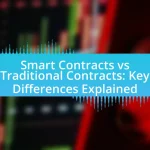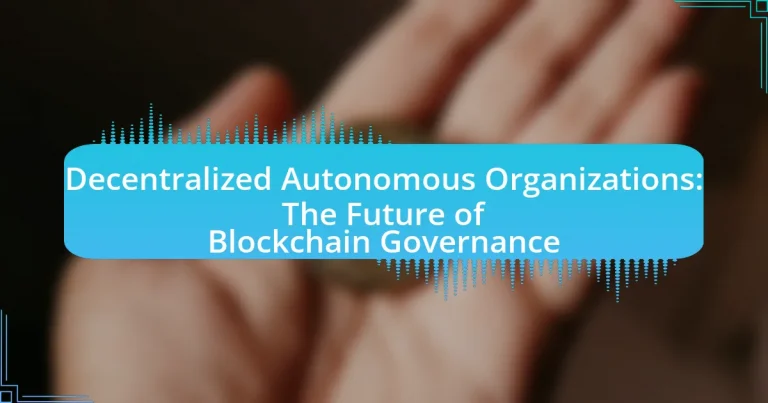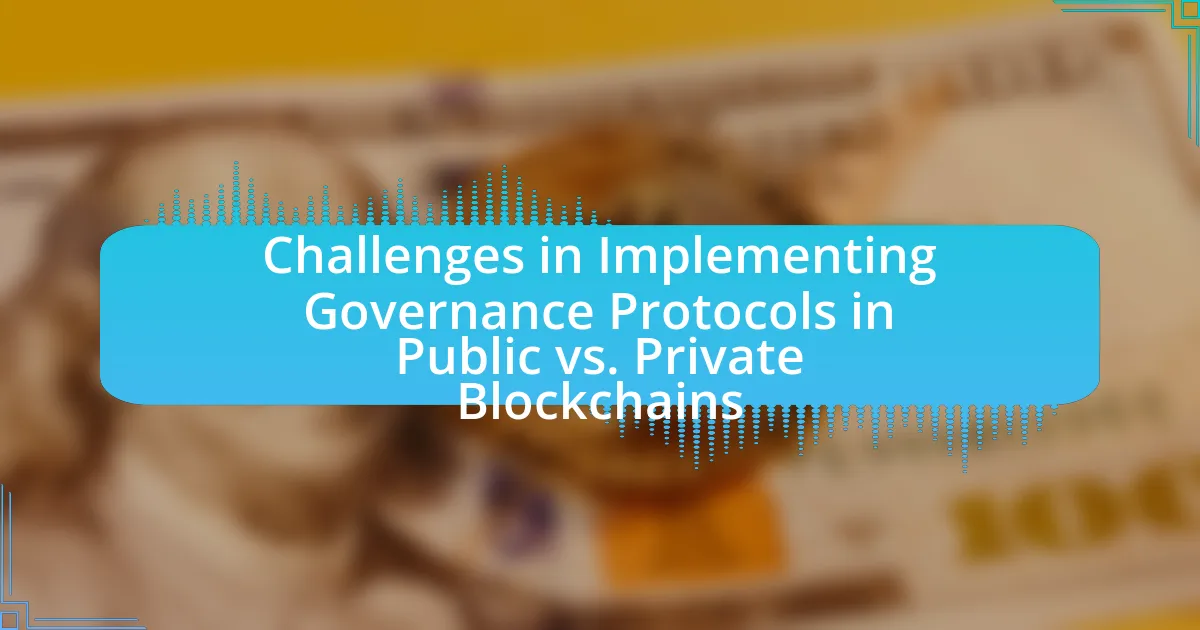Decentralized Autonomous Organizations (DAOs) represent a transformative approach to governance within the blockchain ecosystem, operating through smart contracts to facilitate decentralized decision-making and enhance transparency. This article explores the fundamental components of DAOs, including their structure, governance principles, and the role of smart contracts in automating processes. It also addresses the advantages of DAOs, such as increased community participation and cost efficiencies, while highlighting the challenges they face, including legal recognition and technical vulnerabilities. Furthermore, the article examines emerging trends in DAO governance and their potential impact on traditional governance models, providing insights into best practices for effective participation in DAOs.
--Decentralized-Autonomous-Organizations-(DAOs-1.webp)
What are Decentralized Autonomous Organizations (DAOs)?
Decentralized Autonomous Organizations (DAOs) are entities that operate through smart contracts on a blockchain, enabling governance and decision-making without centralized control. DAOs utilize blockchain technology to automate processes and facilitate collective decision-making among members, often through token-based voting systems. For instance, the Ethereum blockchain supports various DAOs, allowing participants to propose and vote on changes or initiatives, thereby ensuring transparency and accountability in governance. This structure has been validated by the rise of successful DAOs like MakerDAO, which manages a stablecoin through community governance, demonstrating the practical application and effectiveness of DAOs in decentralized governance.
How do DAOs function within the blockchain ecosystem?
Decentralized Autonomous Organizations (DAOs) function within the blockchain ecosystem by utilizing smart contracts to automate governance and decision-making processes. These smart contracts are self-executing agreements coded on the blockchain, allowing members to propose and vote on changes or initiatives without the need for centralized authority. DAOs operate on principles of transparency and decentralization, where all transactions and decisions are recorded on the blockchain, ensuring accountability and trust among participants. For example, the DAO known as MakerDAO governs the DAI stablecoin through community voting, demonstrating how DAOs can effectively manage complex financial systems in a decentralized manner.
What are the key components of a DAO’s structure?
The key components of a DAO’s structure include smart contracts, governance tokens, a decentralized community, and a treasury. Smart contracts automate decision-making and enforce rules without intermediaries, while governance tokens enable members to vote on proposals and influence the direction of the organization. A decentralized community fosters collaboration and participation among members, ensuring diverse input and engagement. The treasury holds funds and resources, which are managed collectively by the community to support initiatives and projects. These components work together to create a self-governing entity that operates transparently and efficiently.
How do smart contracts facilitate DAO operations?
Smart contracts facilitate DAO operations by automating decision-making processes and enforcing rules without the need for intermediaries. These self-executing contracts contain the terms of the agreement directly written into code, allowing DAOs to operate transparently and efficiently. For example, when a proposal is submitted, smart contracts can automatically execute the agreed-upon actions once a certain threshold of votes is reached, ensuring that all members’ decisions are honored without manual intervention. This automation reduces the potential for human error and increases trust among participants, as the rules are immutable and publicly verifiable on the blockchain.
What are the core principles that govern DAOs?
The core principles that govern Decentralized Autonomous Organizations (DAOs) include decentralization, transparency, community governance, and smart contracts. Decentralization ensures that no single entity has control, allowing for distributed decision-making among members. Transparency is achieved through open access to information and decision-making processes, fostering trust among participants. Community governance empowers members to participate in the decision-making process, often through voting mechanisms that reflect the collective will. Smart contracts automate and enforce agreements, ensuring that actions are executed as intended without the need for intermediaries. These principles collectively enable DAOs to operate efficiently and democratically within the blockchain ecosystem.
How does decentralization impact decision-making in DAOs?
Decentralization significantly enhances decision-making in Decentralized Autonomous Organizations (DAOs) by distributing authority among all members rather than centralizing it in a single entity. This structure allows for more democratic participation, as each member can propose and vote on initiatives, leading to decisions that reflect the collective interests of the community. Research indicates that decentralized governance can improve transparency and accountability, as all transactions and decisions are recorded on the blockchain, making them accessible for scrutiny. Furthermore, studies show that DAOs can respond more swiftly to changes in the environment due to their flexible governance structures, which can adapt based on member input and consensus.
What role does transparency play in DAO governance?
Transparency is crucial in DAO governance as it fosters trust among participants and ensures accountability in decision-making processes. By making all transactions, proposals, and voting outcomes publicly accessible, DAOs enable members to verify actions and hold each other accountable. This openness reduces the risk of corruption and mismanagement, as evidenced by the success of DAOs like MakerDAO, where transparent governance mechanisms have led to increased community engagement and trust. Furthermore, studies indicate that transparency in governance structures correlates with higher participation rates, reinforcing the importance of clear communication and visibility in decentralized systems.
What are the advantages of using DAOs for governance?
The advantages of using DAOs for governance include increased transparency, enhanced participation, and reduced centralization of power. DAOs operate on blockchain technology, which ensures that all transactions and decisions are recorded publicly and immutably, fostering trust among participants. This transparency allows stakeholders to verify actions and decisions, reducing the risk of corruption. Additionally, DAOs enable broader participation by allowing anyone with internet access to contribute to governance decisions, thus democratizing the process. Furthermore, DAOs minimize the concentration of power by distributing decision-making authority among members, which can lead to more equitable outcomes. These advantages are supported by the growing adoption of DAOs in various sectors, demonstrating their effectiveness in governance.
How do DAOs enhance community participation?
DAOs enhance community participation by enabling decentralized decision-making, allowing members to vote on proposals and governance issues directly. This structure empowers individuals to have a say in the organization’s direction, fostering a sense of ownership and engagement. For instance, platforms like Aragon and DAOstack facilitate voting mechanisms that ensure every member’s voice can influence outcomes, thereby increasing transparency and accountability. Research indicates that DAOs can lead to higher levels of member involvement compared to traditional organizations, as they eliminate barriers to participation and create a more inclusive environment.
What cost efficiencies do DAOs provide compared to traditional organizations?
Decentralized Autonomous Organizations (DAOs) provide significant cost efficiencies compared to traditional organizations primarily through reduced overhead and streamlined decision-making processes. DAOs eliminate the need for extensive administrative staff and physical infrastructure, as operations are managed through smart contracts on blockchain technology, which automates many functions that would typically require human intervention.
For instance, a study by Deloitte highlights that organizations utilizing blockchain can reduce transaction costs by up to 30% due to increased transparency and reduced fraud. Additionally, DAOs enable global participation without geographical constraints, allowing for a diverse pool of contributors who can work collaboratively without the costs associated with traditional employment models, such as benefits and office space.
These efficiencies not only lower operational costs but also enhance agility and responsiveness to market changes, making DAOs a compelling alternative to traditional organizational structures.

What challenges do DAOs face in implementation?
DAOs face several challenges in implementation, including legal recognition, governance issues, and technical complexities. Legal recognition is a significant hurdle, as many jurisdictions do not have clear regulations for DAOs, leading to uncertainty in liability and compliance. Governance issues arise from the need for effective decision-making processes, as decentralized voting can lead to inefficiencies and conflicts among members. Technical complexities include the reliance on smart contracts, which can be vulnerable to bugs and exploits, potentially jeopardizing the entire organization. These challenges highlight the need for ongoing development and adaptation in the DAO ecosystem.
What legal and regulatory hurdles do DAOs encounter?
Decentralized Autonomous Organizations (DAOs) encounter significant legal and regulatory hurdles primarily due to their lack of clear legal status and the evolving nature of blockchain technology. DAOs often face challenges related to compliance with existing securities laws, as many jurisdictions classify tokens issued by DAOs as securities, which subjects them to stringent regulatory requirements. Additionally, issues surrounding governance, liability, and taxation complicate the operational framework of DAOs, as traditional legal structures do not easily accommodate their decentralized nature. For instance, the U.S. Securities and Exchange Commission (SEC) has indicated that tokens may be considered securities if they meet the Howey Test criteria, leading to potential legal repercussions for DAOs that do not comply. Furthermore, the absence of a centralized authority makes it difficult to enforce contracts and resolve disputes, creating uncertainty in legal interpretations and enforcement.
How do different jurisdictions view DAOs?
Different jurisdictions have varied views on Decentralized Autonomous Organizations (DAOs), with some recognizing them as legal entities while others classify them as unregulated entities. For instance, in the United States, states like Wyoming have enacted legislation that allows DAOs to register as limited liability companies, providing them with legal recognition and protections. Conversely, countries like China have imposed strict regulations on cryptocurrencies and blockchain technologies, leading to a more cautious stance towards DAOs. In the European Union, discussions are ongoing regarding the regulatory framework for DAOs, with proposals suggesting that they may fall under existing corporate laws. These differing perspectives highlight the complexity of DAO regulation across global jurisdictions.
What are the implications of regulatory compliance for DAOs?
Regulatory compliance for Decentralized Autonomous Organizations (DAOs) implies that these entities must adhere to existing laws and regulations, which can significantly impact their operational structure and governance. Compliance may necessitate changes in how DAOs manage funds, make decisions, and interact with users, potentially leading to increased transparency and accountability. For instance, if a DAO is classified as a security under U.S. law, it may be required to register with the Securities and Exchange Commission (SEC) and comply with reporting requirements, which could limit its decentralized nature. Furthermore, regulatory scrutiny can influence investor confidence and market participation, as seen in the case of various blockchain projects that faced legal challenges due to non-compliance.
What technical challenges affect the operation of DAOs?
Technical challenges affecting the operation of Decentralized Autonomous Organizations (DAOs) include scalability, security vulnerabilities, and governance issues. Scalability is a significant concern as many blockchain networks struggle to handle a high volume of transactions efficiently, which can lead to delays and increased costs. Security vulnerabilities arise from smart contract bugs and exploits, which can result in significant financial losses; for instance, the DAO hack in 2016 led to the loss of $60 million worth of Ether due to a flaw in the smart contract code. Governance issues stem from the difficulty in achieving consensus among diverse stakeholders, which can lead to conflicts and inefficiencies in decision-making processes. These challenges hinder the effective functioning and adoption of DAOs in the broader blockchain ecosystem.
How do security vulnerabilities impact DAO functionality?
Security vulnerabilities significantly undermine DAO functionality by exposing the organization to risks such as unauthorized access, manipulation of smart contracts, and loss of funds. For instance, the DAO hack in 2016, which exploited a vulnerability in the Ethereum smart contract, resulted in the loss of approximately $60 million worth of Ether, demonstrating how a single security flaw can lead to catastrophic financial consequences and erode trust in the governance model. Such vulnerabilities can disrupt decision-making processes, hinder operational efficiency, and ultimately threaten the sustainability of the DAO.
What scalability issues do DAOs need to address?
DAOs need to address issues related to transaction throughput, governance participation, and resource allocation to scale effectively. Transaction throughput is limited by the underlying blockchain technology, which can lead to delays and increased costs during high-demand periods. Governance participation often suffers from low engagement, making it difficult to reach consensus on decisions, especially as the number of members grows. Additionally, resource allocation becomes challenging as DAOs expand, requiring efficient mechanisms to manage funds and projects without overwhelming the system. These scalability challenges are critical for DAOs to maintain functionality and effectiveness as they grow.

How are DAOs shaping the future of governance?
DAOs are shaping the future of governance by enabling decentralized decision-making and enhancing transparency in organizational operations. These organizations leverage blockchain technology to facilitate collective decision-making processes, allowing stakeholders to participate directly in governance without intermediaries. For instance, DAOs like MakerDAO and Aragon have demonstrated how token-based voting systems can empower members to influence key decisions, such as protocol upgrades and fund allocations. This shift towards decentralized governance models is supported by the growing adoption of blockchain technology, which provides an immutable record of decisions and actions, thereby increasing accountability and trust among participants.
What trends are emerging in the DAO landscape?
Emerging trends in the DAO landscape include increased regulatory scrutiny, the rise of hybrid governance models, and enhanced interoperability among DAOs. Regulatory scrutiny is intensifying as governments seek to establish frameworks for compliance, impacting how DAOs operate. Hybrid governance models are gaining traction, combining on-chain and off-chain decision-making processes to improve efficiency and inclusivity. Additionally, interoperability is becoming crucial as DAOs aim to collaborate across different blockchain ecosystems, facilitating resource sharing and joint initiatives. These trends reflect the evolving nature of decentralized governance and the need for adaptability in a rapidly changing environment.
How are DAOs influencing traditional governance models?
DAOs are influencing traditional governance models by introducing decentralized decision-making processes that enhance transparency and participation. Unlike conventional governance structures, which often rely on hierarchical authority, DAOs empower stakeholders to vote on proposals directly, thereby democratizing power. For instance, the DAO model utilized by platforms like Aragon allows users to create and manage their own governance frameworks, showcasing how blockchain technology can facilitate more inclusive and efficient governance. This shift is evidenced by the increasing adoption of DAOs in various sectors, including finance and social organizations, where they are replacing traditional boards and committees with community-driven governance.
What innovations are being introduced in DAO governance?
Innovations in DAO governance include the implementation of quadratic voting, which allows members to express the intensity of their preferences, and the use of on-chain governance mechanisms that automate decision-making processes. Quadratic voting enhances democratic participation by enabling users to allocate votes based on the strength of their opinions, thereby reducing the influence of wealth on voting outcomes. On-chain governance mechanisms streamline proposals and voting, ensuring transparency and efficiency in decision-making. These innovations are supported by the growing adoption of blockchain technology, which facilitates secure and transparent governance structures, as evidenced by successful DAOs like MakerDAO and Aragon, which have effectively utilized these methods to enhance community engagement and governance efficiency.
What are the best practices for participating in a DAO?
The best practices for participating in a DAO include understanding the governance structure, actively engaging in discussions, and voting on proposals. Participants should familiarize themselves with the DAO’s mission, rules, and decision-making processes to contribute effectively. Engaging in discussions allows members to share insights and perspectives, fostering a collaborative environment. Voting on proposals is crucial, as it directly influences the direction of the DAO and ensures that decisions reflect the collective will of its members. These practices enhance transparency, accountability, and community involvement, which are essential for the success of a DAO.
How can individuals effectively engage in DAO decision-making?
Individuals can effectively engage in DAO decision-making by actively participating in discussions, voting on proposals, and contributing to governance forums. Active participation allows individuals to voice their opinions and influence outcomes, while voting ensures that their preferences are reflected in the decisions made by the DAO. Contributing to governance forums provides a platform for sharing insights and collaborating with other members, fostering a more informed decision-making process. Research indicates that DAOs with higher member engagement tend to make more balanced and representative decisions, highlighting the importance of individual involvement in the governance structure.
What strategies can enhance the success of a DAO?
To enhance the success of a Decentralized Autonomous Organization (DAO), implementing clear governance structures is essential. Effective governance ensures that decision-making processes are transparent and inclusive, allowing all members to participate meaningfully. Research indicates that DAOs with well-defined roles and responsibilities experience higher engagement and satisfaction among participants, leading to better outcomes. For instance, the DAO Maker project demonstrated that structured voting mechanisms and clear communication channels significantly improved member involvement and project success rates.
It is not possible to provide an answer to the question “
” as it does not contain a specific inquiry or context to address.

















